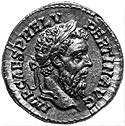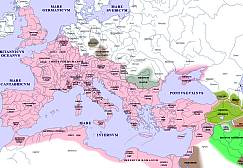
 Virtual
Catalog of Roman Coins
Virtual
Catalog of Roman Coins

An Online Encyclopedia of Roman Emperors Pertinax (192-193 A.D.)
Michael L. Meckler
Ohio State University

Publius Helvius Pertinax rose from humble origins to sit on the throne of the Caesars, but his three-month reign marked merely the beginning of years of civil war after the murder of Commodus.Pertinax was born 1 August 126 in the Ligurian town of Alba Pompeia (modern Alba), roughly 35 miles southeast of Turin in northwest Italy. His father, Helvius Successus, was a freedman, and like another freedman's son -- the poet Horace -- the young Pertinax gained a foothold in Roman society through education and erudition. Pertinax went to Rome as a student of the grammarian Sulpicius Apollinaris and then became a teacher of grammar himself -- an occupation shared with one other imperial claimant, the late fourth-century usurper Eugenius.
When he reached his mid-30s, Pertinax decided to change careers, and he entered the army as a low-level officer in charge of a cohort. He rose quickly through at first military, then later civilian administrative positions, and he could count on the patronage of Claudius Pompeianus, a Syrian who soon married into the imperial family. Pompeianus became the husband of Lucilla, the daughter of the emperor Marcus Aurelius, after the death of Lucilla's first husband, the co-emperor Lucius Verus. Pertinax gained his own important father-in-law, the ex-consul Flavius Sulpicianus.
About this time, in the early 170s, Pertinax was adlected into the senate and served as the commander of a legion. In 175 he was named a suffect consul, an honor he shared with Didius Julianus. Pertinax held several provincial governorships, including the prestigious post of proconsul of Africa, before being picked by Commodus to run the city of Rome as urban in 189.
Commodus' behavior was becoming ever more erratic, and in the fall of 192 both the emperor's chamberlain, Eclectus, and the Praetorian Prefect Laetus feared Commodus might soon order their executions. A plot was hatched within the imperial household to have Commodus killed. The plot succeeded on 31 December 192. Despite public displays of ignorance by the conspirators, Pertinax seems to have been their chosen successor from the start. The influence of Claudius Pompeianus was still apparent, for this erstwhile patron of Pertinax returned to Rome and public life once the plot unfolded.
While Pertinax, like the emperor Vespasian, was not born into a senatorial family, he may have seemed -- to the conspirators-- like Nerva , who succeeded the assassinated Domitian. Like Nerva, Pertinax was relatively old (age 66), and Pertinax had an excellent reputation among senators. Pertinax even revived the republican title of princeps senatus ("leading man of the senate"), which the new emperor bore in deference to Rome's aristocratic class.
Unlike Nerva, Pertinax had children, but the new emperor took the unusual step of giving away his personal estate to his nearly grown-up son and daughter. Pertinax also refused to allow his children to live at the imperial residence on the Palatine and instead had the pair reside at the home of their grandfather, Flavius Sulpicianus. For public purposes, Pertinax now appeared to have no heir.
Regardless of how much Pertinax wanted to seem a new Nerva, Pertinax would not share Nerva's peaceful death. Pertinax was a prudent manager, and he found that there was not enough money in the treasury to give the soldiers as a large a donative as they were wont to receive. The troops' resentment was compounded when the emperor made remarks to justify the amount of the donative, remarks perceived by the troops as a lie.
Soldiers of the Praetorian Guard planned a coup while Pertinax was in Ostia overseeing the grain supply. The troops intended to proclaim the consul Sosius Falco as emperor, but Pertinax learned of the plot and rushed back to Rome to defuse it. Squabbling between Pertinax and the praetorian prefect Laetus allowed military discipline to break down even further, and on 28 March 193 a group of soldiers mutinied and entered the imperial residence. In a clumsy attempt to quell the disturbance, Pertinax personally confronted the troops and was killed.
Pertinax reigned for eighty-seven days. He would be deified by Septimius Severus, who some scholars have argued was meant to be the Trajan to Pertinax's Nerva. The historical tradition remained kind to Pertinax, who was remembered as a respectful and modest leader killed because of the avarice of soldiers.
PRIMARY SOURCES:
Cassius Dio, Roman History, bk.73, ch.1-10 (available in English translation in the Loeb Classical Library)
Herodian, bk.2, ch.1-5 (also available in the Loeb Classical Library)
Historia Augusta, Life of Pertinax (English translations available in the Loeb Classical Library and in a Penguin translation, Lives of later Caesars, tr. Anthony Birley
RECENT BIBLIOGRAPHY:
Geza Alföldy, Römisches Heeresgeschichte, Beiträge 1962-1985 (Amsterdam: Gieben, 1987), pp.326-48.
Anthony R. Birley, Septimius Severus: the African emperor, 2nd edition (New Haven, Conn.: Yale, 1988)
André Chastagnol, Histoire Auguste (Paris: Robert Laffont, 1994), pp.249-75
H. Devijver, "Les militiae equestres de P. Helvius Pertinax." ZPE, 75(1988), 207ff.
J.B. Leaning. "Didius Julianus and His Biographer." Latomus, 48(1989), 548ff.
M. Philippides. "Herodian 2.4.1 and Pertinax." CW 77(1984), 315-336.>
G. Pignata. "Cenni sulla carriera militare e politica di Publio Elvio Pertinace." Atti e Memorie dell Soc. Savonese di Storia Patria (Savona), n.s. 11(1977), 7ff
R. Soraci. "L'opera legislativa di Pertinace." QCSCM, 6(1984), 315ff.
Comments to: Michael L. Meckler.
Updated: 10 December 1997
For more detailed geographical information, please use the DIR/ORBAntique and Medieval Atlas below. Click on the appropriate part of the map below to access large area maps.
